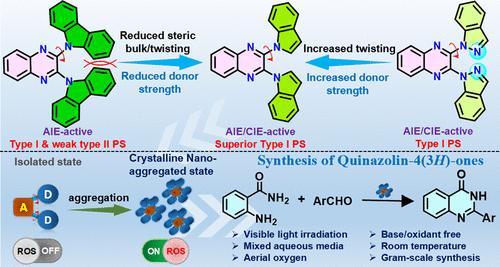Understanding the Structural Modulations in Twisted Donor–Acceptor–Donor (D-A-D) Systems for Boosting Type I Photosensitizing Photocatalytic Activity
IF 8.3
2区 材料科学
Q1 MATERIALS SCIENCE, MULTIDISCIPLINARY
引用次数: 0
Abstract
Supramolecular assemblies based on the twisted donor–acceptor–donor (D-A-D) building block Qx-Ind have been developed, which interestingly, due to the balanced angle of twist (38.28°), high intermolecular charge transfer, and crystallization induced emission (CIE) characteristics, exhibit high molar absorptivity and a long-lived “lighted” excited state at the supramolecular level. The validity of the design concept was examined by preparing CIE active D-A-D system Qx-Indaz (weak donor, low angle of twist: 35.45°), in which, due to the insertion of an additional binding site for noncovalent interactions, a drastic change in the photophysical behavior is observed. The combined spectroscopic studies of all the compounds unveil the strong impact of modulation of the angle of twist and intermolecular charge transfer upon photophysical behavior in the aggregated state. Due to the favorable photophysical behavior, the supramolecular assemblies of Qx-Ind exhibit high type I photosensitizing activity in comparison to Qx-Indaz. The superior type I photosensitizing activity of Qx-Ind assemblies is manifested in their ability to efficiently catalyze the aerobic oxidative synthesis of quinazolin-4(3H)-ones (via type I ROS) from 2-aminobenzamide and aromatic aldehydes in the absence of additional additives (base/oxidant). Unlike photocatalytic nanoassemblies reported in the literature, due to the CIE characteristics, Qx-Ind does not require preliminary preparation and could be directly introduced in the solid state to reaction media. Thus, the present work demonstrates a simple strategy of upgrading type I photosensitizing activity by improving the ground/excited state behavior of a twisted D-A-D system through modulation of the angle of twist and charge transfer characteristics.

了解扭曲供体-受体-供体(D-A-D)系统中的结构调整,提高 I 型光敏光催化活性
基于扭曲的供体-受体-供体(D-A-D)结构单元 Qx-Ind 开发出了超分子组装体,有趣的是,由于平衡的扭曲角(38.28°)、高分子间电荷转移和结晶诱导发射(CIE)特性,这些组装体在超分子水平上表现出高摩尔吸收率和长寿命的 "点亮 "激发态。通过制备 CIE 活性 D-A-D 系统 Qx-Indaz(弱供体,低扭转角:35.45°),检验了设计概念的有效性。对所有化合物进行的综合光谱研究揭示了扭曲角的调节和分子间电荷转移对聚集态光物理行为的强烈影响。由于具有良好的光物理行为,与 Qx-Indaz 相比,Qx-Ind 的超分子集合体具有很高的 I 型光敏活性。Qx-Ind 集合体卓越的 I 型光敏活性表现在它们能够在没有额外添加剂(碱/氧化剂)的情况下,高效催化 2- 氨基苯甲酰胺和芳香醛有氧氧化合成喹唑啉-4(3H)-酮(通过 I 型 ROS)。与文献中报道的光催化纳米组件不同,Qx-Ind 因其 CIE 特性而无需进行初步制备,可在固态下直接引入反应介质。因此,本研究工作展示了一种简单的策略,即通过调节扭曲角度和电荷转移特性来改善扭曲 D-A-D 系统的基态/激发态行为,从而提高 I 型光敏活性。
本文章由计算机程序翻译,如有差异,请以英文原文为准。
求助全文
约1分钟内获得全文
求助全文
来源期刊

ACS Applied Materials & Interfaces
工程技术-材料科学:综合
CiteScore
16.00
自引率
6.30%
发文量
4978
审稿时长
1.8 months
期刊介绍:
ACS Applied Materials & Interfaces is a leading interdisciplinary journal that brings together chemists, engineers, physicists, and biologists to explore the development and utilization of newly-discovered materials and interfacial processes for specific applications. Our journal has experienced remarkable growth since its establishment in 2009, both in terms of the number of articles published and the impact of the research showcased. We are proud to foster a truly global community, with the majority of published articles originating from outside the United States, reflecting the rapid growth of applied research worldwide.
 求助内容:
求助内容: 应助结果提醒方式:
应助结果提醒方式:


